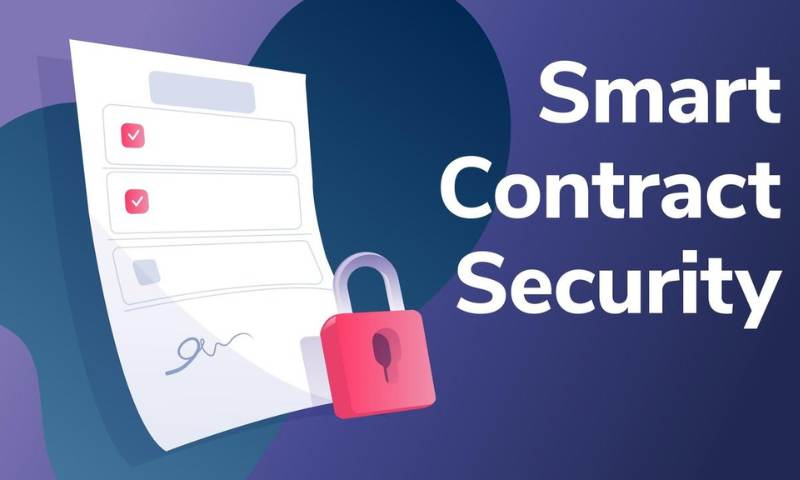The security of smart contracts is your digital armor in the online deal-making world. Imagine locking in deals with full trust, no sweat about sneaky breaches or costly cracks in your contracts. With cyber threats looming large, you need smart tactics to keep your blockchain bonds tight and right. In this dive into digital self-defense, I’ll unpack the no-nonsense moves that bulletproof your smart contract shields, because when it comes to your coins, only ironclad will do. Let’s tackle the tech and tighten your transaction game before disaster can even think of knocking.
Understanding Smart Contract Vulnerabilities and Blockchain Technology
Identifying Common Smart Contract Exploits
Smart contract vulnerabilities are weak spots. Hackers love these. They use them to break in and steal. It’s like leaving your house keys out. Someone will find them and get in. But unlike a stolen TV, you could lose a fortune with smart contract hacks.
Most smart contract mistakes come from code errors. Simple bugs can cause big problems. Think about a locked door that opens with any key, not just yours. This is kind of like a reentrancy attack. Once in, hackers can take funds over and over. It’s a loop with no end, until everything’s gone.
Another big threat is Oracle manipulation. Oracles are data feeders for contracts. If someone tricks the oracle, your smart contract gets the wrong info. This is like a weather app telling you it’s sunny when it’s really raining.
There’s also gas limit vulnerabilities. Gas is the fee for doing stuff on Ethereum. It’s like a ticket to the carnival. But if the ride costs too much, you can’t go. Hackers can make you use all your gas. It’s like a never-ending ride that drains your wallet.
Now, we want to stop these bad things. How? We can audit our contracts. This means checking them really well, using special tools. It’s like a doctor’s check-up, but for code.
The Role of Blockchain in Smart Contract Security
Blockchain technology is key to smart contract security. Why? Because it’s a strong, shared record book. When someone writes in it, everyone can see. This makes it hard for folks to cheat.
The blockchain stores contracts forever. We say it’s immutable, like a tattoo you can’t wash off. Safe? Yes. But tricky too. Any mistake is there to stay. It’s like sending an email you can’t take back. Always be sure before you hit send.
And don’t forget, blockchains work together. It’s like a team sport. All players must agree to make a play. This is called a consensus mechanism. It’s great for security. It’s like having five friends confirm it’s raining, not just one. It makes sure no one lies about the weather.
But blockchain isn’t perfect. As it grows, we find more and more challenges. Big ones include privacy, scaling, and security trade-offs. Security trade-offs are tough choices. It’s like choosing between a fast bike with no helmet or a slow bike with one. We want to be fast and safe. But it’s hard to be both.
In short, smart contracts and blockchain are powerful. But they come with risks. It’s up to us to handle these risks right. We put safety measures in place, we watch out for dangers, and we stay smart. Just like crossing the street. Look both ways, be alert, and you’ll get to the other side OK.
Auditing Smart Contracts for Enhanced Security
Employing Auditing Tools for Comprehensive Analysis
In smart contract security, missing a bug is not an option. Think of auditing tools like superheroes for your code, always on guard, ready to spot those sneaky bugs that could lead to trouble. To check for security holes, these tools scan your smart contract code. They look at each line to find anything that might let hackers in.
When we audit smart contracts, we use top-notch tools for a deep look at the code. We check for errors that could let someone steal digital money or mess with the contract. I use tools that see things that the eye can’t catch. This helps us trust the contract better. Think of it like a health test for your contract. The tools tell us “Hey, this part looks weak” or “Be careful here; it could break!” So, we get a chance to fix it fast and keep it strong.
The Importance of Formal Verification and Peer Review
Now, before going live with a contract, we make extra sure it’s airtight. How? By using something called formal verification and peer review.
Formal verification is like a math proof for your contract. It checks if the contract will do what it says, no more, no less. We use smart logic to prove that the code is mistake-free. Peer review means other experts check the work. They bring fresh eyes to spot anything we might have missed. It’s like when you write a story and have others read it. They can point out parts that don’t make sense or find spots that could be better.
These two steps – formal verification and having a buddy check your work – are key to making sure contracts do their job right, without leaving doors open for thieves. When we go through these steps, we’re not just checking boxes. We’re building trust in the digital world, making it safer for everyone to make deals and trade.
Using smart contract best practices is serious business. We have to be like detectives, always on the lookout for clues that something might go wrong. And when we find these clues, we work hard to fix them. We know that in the blockchain world, mistakes can be permanent. That’s why we don’t rush.
Security in the creative world of coding is both an art and a skill. It’s about protecting all the amazing things people build on blockchains. From games to finance to art, we do the heavy lifting behind the scenes to keep it all safe.
Making contracts bulletproof is what we live for – it’s a blend of tech magic and hard work. But the real win is when people can trade and make deals, trusting that the digital world has their back. That’s what keeps us going. That’s why we always aim for perfection, for that 100% score, because in blockchain, there’s little room for error. Let’s keep building this digital future, but let’s also make sure it’s as solid as the ground beneath our feet.
Implementing Robust Security Measures in Smart Contract Development
Best Practices for Secure Smart Contract Development
Safe smart contract development is vital. We must follow set steps. These steps block many attacks. They make sure contracts do what they should. Here’s how you keep your digital deals tight.
First, know the code you write. Understand every line. Next, test it. Break it if you can. Fix what breaks. Use tools made to scan for errors. People across the globe make these tools. They help catch things we might miss.
Write simple code. Avoid big, complex parts. These parts can hide bugs. Errors in smart contracts can be costly. They can cause lost money or broken trust. We do not want this. Keeping code simple helps avoid such problems. It also makes smart contracts easier to check.
Limit what others can change. If you let others tweak too much, it can be risky. Lock down things you don’t want touched.
Lastly, keep learning. Tech changes fast. Staying up to date on blockchain and coding helps you write safer contracts.
Follow these steps. You will build stronger and safer smart contracts.
Leveraging Bug Bounties and Security Patterns
Bug bounties are cool. They invite coders to find flaws. It’s like a treasure hunt for bugs. When coders find bugs, they tell you. Then you fix them. This helps make your smart contract tough like a fortress.
Let’s talk security patterns. These are like rules in a game. They guide you. Following them can shield you from certain attacks. There are many patterns. Each has a role. Some keep data safe. Others manage how transactions happen.
One key pattern is checks-effects-interactions. It makes sure steps happen in order. This reduces risks. Risks like reentrancy attacks, where hackers take money in a sneaky loop.
Use patterns like building with Legos. Build step by step. Be careful. Each piece matters. It adds to your smart contract’s safety.
Bug bounties and patterns give everyone confidence. They show you care about safety. They can prevent a lot of grief. So, put on your coding cape. Fight off those contract villains. Make your smart contract a safe place for digital deals!
Navigating Legal and Compliance Aspects of Smart Contracts
Understanding the Legal Framework of Digital Contracts
Smart contracts are like robot handshake deals. They agree on stuff for us. These digital deals live on a blockchain. This is a space where lots of computers agree on who owns what. Just like a playground pact needs playground rules, smart contracts need laws too.
So, what’s a law for a smart contract? Countries are now working this out. They’re writing rules on how we make, use, and fix smart contracts. A smart contract must play by these rules. If not, it might not stand up in court.
Think of a playground. If one kid doesn’t play fair, a teacher steps in, right? It’s like that. If someone says a smart contract isn’t fair, judges look at the laws to decide. This means if you’re making or using smart contracts, you need to know the rules.
Why should we care? If we don’t, things can go very wrong. Money could be lost. People could get angry. So, we keep contracts clean and above board. Knowing the law keeps everyone on the same page.
Mitigating Risks with Smart Contract Compliance and Update Mechanisms
Making a smart contract is just the start. What if things change? Or if a mistake sneaks in? We need ways to fix things without breaking the whole deal.
Let’s take a bike with training wheels. At first, we need them. But once we get better at cycling, we take them off. Smart contracts also get updates. This keeps them rolling smooth. We call this a smart contract update mechanism. It helps fix mistakes or add new stuff as we go.
But with every update, we must check the rules. We call this compliance. It means our smart contract is still a good player in the legal game. This is important. Breaking rules can lead to trouble.
Auditing smart contracts is another way to stay safe. This is like a spell check for your contract. It spots problems before they get bigger. There are tools to help with this. These tools look at the code and say, “Hey, this could go wrong!”
We also plan for bad things, just in case. What if someone tries to cheat? We have safety measures for this. One trick is called reentrancy attack smart contract. That’s like a lock on a diary. It keeps others from changing the story.
In smart contracts, a reentrancy attack is a big deal. It’s like a line cutter. It jumps the queue and grabs more than its share. We don’t want that.
To block these tricks, we use smart contract threat mitigation. So our digital deal stays safe. By planning ahead, we stop disasters.
To sum it up, think of smart contracts as a bike we ride on the blockchain. Knowing the laws is like knowing how to pedal. Updates are the gears that keep things moving. Safety measures and audits? They’re our helmet and knee pads.
Playing in this new digital space can be fun. But we’ve got to stay sharp. We watch the rules, fix our mistakes, and guard against cheats. This way, our smart contract can be a winning move for everyone.
We dove deep into smart contracts, from the risks they face to how we can make them safer. We looked at common ways they can break and how blockchain tech adds layers of security. It’s clear that checking them well is key to finding weak spots.
Tools and teammates help give a smart contract a strong backbone. If we get it right, every line of code can stand strong. We also learned that smart coding habits can block bugs from sneaking in. Bug bounties are like treasure hunts for finding risks before they blow up.
But it’s not all about the code. The law steps in too. Understanding rules helps us write smart contracts that won’t land us in trouble. Updates keep contracts in line with changing laws.
In closing, smart contracts are mighty, but they’re not perfect. It’s on us to keep pushing for top-notch security in every part we code and use. Let’s build trust in the tech we rely on every day.
Q&A :
How Do Smart Contracts Ensure Security in Transactions?
Smart contracts aim to provide high security in transactions by automating contract execution upon fulfillment of predefined conditions, which reduces human error and interference. Their code is immutable once deployed to a blockchain, which means that neither party can alter the agreement without mutual consent. Additionally, the decentralized nature of blockchain makes it difficult for external parties to hack or manipulate the contract.
What Are the Common Security Risks Associated with Smart Contracts?
Despite their advantages, smart contracts can be susceptible to risks such as:
- Bugs and vulnerabilities within the contract’s code that can be exploited
- Issues with the underlying blockchain platform, which may affect contract integrity
- Inadequate testing and auditing of contracts before deployment
- Oracle manipulation, if the contract relies on external data sources
Mitigating these risks involves rigorous testing, code audits, and employing best practices in smart contract development.
Can Smart Contract Security Be Audited and Enhanced Post-Deployment?
Auditing smart contract security is essential pre-deployment; however, once deployed, the immutability of blockchain makes it problematic to alter the contract’s code. But there are methods to enhance security:
- Deploying upgradeable smart contracts using proxies
- Utilizing circuit breakers to halt contract functions in case of a detected issue
- Performing periodic security reviews and keeping abreast of new vulnerabilities
These practices help in maintaining the security of smart contracts even after they are live.
What Standards Are in Place to Ensure the Security of Smart Contracts?
Standards such as the Ethereum’s ERC-20 and ERC-721 have been established to ensure smart contracts’ security and interoperability. Furthermore, organizations may follow:
- Security frameworks and best practices outlined by industry leaders
- Independent security audits from reputable firms
- Continuous professional assessment of contract code and architecture
These standards help developers create and maintain secure smart contracts.
How Can End Users Trust the Security of Smart Contracts?
To trust the security of smart contracts, end users should:
- Look for smart contracts that have undergone thorough security audits made available publicly
- Ensure the platform has a good track record and reviews from users
- Understand that smart contract interactions carry inherent risks, and consider insurance options when applicable
User trust is fostered by transparency, a proven history of security, and an educated approach to using smart contracts.


